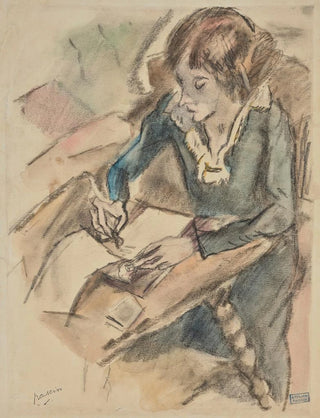Art print | Woman writing - Jules Pascin


View from behind

Frame (optional)
In the vibrant universe of art, some works stand out for their ability to capture the very essence of the moment. "Femme écrivant" by Jules Pascin is one of those creations that evoke palpable intimacy. Gazing at this piece, the viewer is immediately transported to a world where the tenderness of gestures and the depth of emotions intertwine. Pascin, through his genius, manages to freeze time, immortalizing a woman absorbed in the act of writing, thus revealing a part of her psyche and inner universe. This painting, full of life and authenticity, invites us to share a privileged moment, a pause amid the tumult of everyday life.
Style and uniqueness of the work
Jules Pascin's style is both delicate and powerful, oscillating between apparent lightness and emotional depth. In "Femme écrivant," the flowing lines and soft colors intertwine to create an almost dreamlike atmosphere. The artist plays with light and shadow, creating a subtle contrast that highlights the female figure while maintaining a certain intimacy. The woman's posture, leaning over her writing, suggests intense concentration, while her environment, though minimalist, evokes domestic warmth. This piece is an ode to creativity, introspection, and the beauty of everyday gestures, thus revealing Pascin's singularity, who manages to transform an ordinary scene into a moment of great poetry.
The artist and his influence
Jules Pascin, born in Bulgaria and having found his artistic path in Paris, is an emblematic artist of the early 20th century. His journey, marked by diverse influences ranging from Fauvism to Expressionism, allowed him to develop a unique style that still captivates today. Pascin was able to depict Parisian life with rare sensitivity, highlighting women, artists, and marginalized individuals of his time. His work transcends simple figurative representations to explore universal themes such as solitude, love, and the search for self. By incorporating autobiographical elements into his paintings, Pascin offers a deeply personal vision of his world, which

Matte finish

View from behind

Frame (optional)
In the vibrant universe of art, some works stand out for their ability to capture the very essence of the moment. "Femme écrivant" by Jules Pascin is one of those creations that evoke palpable intimacy. Gazing at this piece, the viewer is immediately transported to a world where the tenderness of gestures and the depth of emotions intertwine. Pascin, through his genius, manages to freeze time, immortalizing a woman absorbed in the act of writing, thus revealing a part of her psyche and inner universe. This painting, full of life and authenticity, invites us to share a privileged moment, a pause amid the tumult of everyday life.
Style and uniqueness of the work
Jules Pascin's style is both delicate and powerful, oscillating between apparent lightness and emotional depth. In "Femme écrivant," the flowing lines and soft colors intertwine to create an almost dreamlike atmosphere. The artist plays with light and shadow, creating a subtle contrast that highlights the female figure while maintaining a certain intimacy. The woman's posture, leaning over her writing, suggests intense concentration, while her environment, though minimalist, evokes domestic warmth. This piece is an ode to creativity, introspection, and the beauty of everyday gestures, thus revealing Pascin's singularity, who manages to transform an ordinary scene into a moment of great poetry.
The artist and his influence
Jules Pascin, born in Bulgaria and having found his artistic path in Paris, is an emblematic artist of the early 20th century. His journey, marked by diverse influences ranging from Fauvism to Expressionism, allowed him to develop a unique style that still captivates today. Pascin was able to depict Parisian life with rare sensitivity, highlighting women, artists, and marginalized individuals of his time. His work transcends simple figurative representations to explore universal themes such as solitude, love, and the search for self. By incorporating autobiographical elements into his paintings, Pascin offers a deeply personal vision of his world, which






